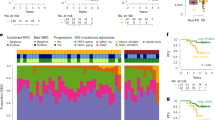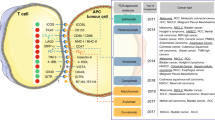Abstract
With the improvement of treatment options, multiple myeloma related life expectancy has been prolonged, but the disease remains largely incurable. Immunotherapy is a growing field that shows promise in advancements for treatment, and recent work has demonstrated an opportunity to use immune receptor, complementarity determining region-3 (CDR3)-candidate antigen chemical complementarity scores to identify survival distinctions among subgroups of patients. Here, we have applied the complementarity scoring algorithm to identify multiple myeloma related, CDR3-cancer testis antigen (CTA) relationships associated with survival distinctions. Furthermore, we have overlapped these immune receptor features with a previous study that showed a dramatic survival distinction based on T-cell receptor, V- and J-gene segment usage, HLA allele combinations, whereby 100% of the patients in certain combination groups had no mortality related to multiple myeloma, during the study period. This overlap evaluation was consistent with the idea that there are likely considerable constraints on productive TRB-antigen-HLA combinations but more flexibility, and unpredictability, for the TRA-antigen-HLA combinations. Also, the approaches in this reported indicated the potential importance of the CTA, IGSF11, as a multiple myeloma antigen, an antigen previously, independently considered as a vaccine candidate in other settings.
This is a preview of subscription content, access via your institution
Access options
Subscribe to this journal
Receive 6 digital issues and online access to articles
$119.00 per year
only $19.83 per issue
Buy this article
- Purchase on Springer Link
- Instant access to full article PDF
Prices may be subject to local taxes which are calculated during checkout


Similar content being viewed by others
Data availability
As noted above, original data are available in the supporting online material file as well as in the supporting online material for ref. [11].
References
Gerecke C, Fuhrmann S, Strifler S, Schmidt-Hieber M, Einsele H, Knop S. The Diagnosis and Treatment of Multiple Myeloma. Dtsch Arztebl Int 2016;113:470–6. https://doi.org/10.3238/arztebl.2016.0470.
Mohty M, Cavo M, Fink L, Gonzalez-McQuire S, Leleu H, Mateos MV, et al. Understanding mortality in multiple myeloma: Findings of a European retrospective chart review. Eur J Haematol. 2019;103:107–15. https://doi.org/10.1111/ejh.13264.
Rasche L, Wasch R, Munder M, Goldschmidt H, Raab MS. Novel immunotherapies in multiple myeloma - chances and challenges. Haematologica. 2021;106:2555–65. https://doi.org/10.3324/haematol.2020.266858.
Yu B, Jiang T, Liu D. BCMA-targeted immunotherapy for multiple myeloma. J Hematol Oncol. 2020;13:125 https://doi.org/10.1186/s13045-020-00962-7.
Munshi NC, Anderson LD Jr, Shah N, Madduri D, Berdeja J, Lonial S, et al. Idecabtagene Vicleucel in Relapsed and Refractory Multiple Myeloma. N Engl J Med. 2021;384:705–16. https://doi.org/10.1056/NEJMoa2024850.
Caraccio C, Krishna S, Phillips DJ, Schurch CM. Bispecific Antibodies for Multiple Myeloma: A Review of Targets, Drugs, Clinical Trials, and Future Directions. Front Immunol. 2020;11:501 https://doi.org/10.3389/fimmu.2020.00501.
Chobrutskiy BI, Chobrutskiy A, Zaman S, Yeagley M, Huda TI, Blanck G. High-throughput, sliding-window algorithm for assessing chemical complementarity between immune receptor CDR3 domains and cancer mutant peptides: TRG-PIK3CA interactions and breast cancer. Mol Immunol. 2021;135:247–53. https://doi.org/10.1016/j.molimm.2021.02.026.
Eakins RA, Chobrutskiy A, Teer JK, Patel DN, Hsiang M, Huda TI, et al. Chemical complementarity between tumor resident, T-cell receptor CDR3s and MAGEA3/6 correlates with increased melanoma survival: Potential relevance to MAGE vaccine auto-reactivity. Mol Immunol. 2022;150:58–66. https://doi.org/10.1016/j.molimm.2022.08.001.
Patel AR, Patel DN, Tu YN, Yeagley M, Chobrutskiy A, Chobrutskiy BI, et al. Chemical complementarity between immune receptor CDR3s and candidate cancer antigens correlating with reduced survival: evidence for outcome mitigation with corticosteroid treatments. J Biomol Struct Dyn. 2022:1–9. Epub 20220510. https://doi.org/10.1080/07391102.2022.2070546.
Huda TI, Diaz MJ, Gozlan EC, Chobrutskiy A, Chobrutskiy BI, Blanck G. Immunogenomics Parameters for Patient Stratification in Alzheimer’s Disease. J Alzheimers Dis. 2022. Epub 20220603. https://doi.org/10.3233/JAD-220119.
Huda TI, Mihyu M, Gozlan EC, Arndt MF, Diaz MJ, Zaman S, et al. Specific HLA alleles, paired with TCR V- and J-gene segment usage, link to distinct multiple myeloma survival rates. Leukemia Lymphoma. 2021:1–15. https://doi.org/10.1080/10428194.2021.1885655.
Gill TR, Samy MD, Butler SN, Mauro JA, Sexton WJ, Blanck G. Detection of Productively Rearranged TcR-alpha V-J Sequences in TCGA Exome Files: Implications for Tumor Immunoscoring and Recovery of Antitumor T-cells. Cancer Inf. 2016;15:23–8. https://doi.org/10.4137/CIN.S35784.
Tong WL, Tu YN, Samy MD, Sexton WJ, Blanck G. Identification of immunoglobulin V(D)J recombinations in solid tumor specimen exome files: Evidence for high level B-cell infiltrates in breast cancer. Hum Vaccines Immunother. 2017;13:501–6. https://doi.org/10.1080/21645515.2016.1246095.
Chobrutskiy BI, Zaman S, Tong WL, Diviney A, Blanck G. Recovery of T-cell receptor V(D)J recombination reads from lower grade glioma exome files correlates with reduced survival and advanced cancer grade. J Neurooncol. 2018;140:697–704. https://doi.org/10.1007/s11060-018-03001-1.
Cios KJ, Huda TI, Eakins RA, Mihyu MM, Blanck G. Specific TCR V-J gene segment recombinations leading to the identification pan-V-J CDR3s associated with survival distinctions: diffuse large B-cell lymphoma. Leukemia Lymphoma. 2022:1–9. Epub 20220112. https://doi.org/10.1080/10428194.2021.2020781.
Chobrutskiy BI, Yeagley M, Tipping P, Zaman S, Diviney A, Patel DN, et al. Chemical complementarity between immune receptor CDR3s and IDH1 mutants correlates with increased survival for lower grade glioma. Oncogene 2020;39:1773–83. https://doi.org/10.1038/s41388-019-1101-2.
Yeagley M, Chobrutskiy BI, Gozlan EC, Medikonda N, Patel DN, Falasiri S, et al. Electrostatic Complementarity of T-Cell Receptor-Alpha CDR3 Domains and Mutant Amino Acids Is Associated with Better Survival Rates for Sarcomas. Pediatr Hematol Oncol. 2021:1–14. https://doi.org/10.1080/08880018.2020.1843576.
Arturo JF, Chobrutskiy BI, Yeagley M, Patel DN, Falasiri S, Patel JS, et al. Electrostatic complementarity of B-cell receptor CDR3s and TP53-mutant amino acids in breast cancer is associated with increased disease-free survival rates. Cell Mol Immunol. 2020;17:776–8. https://doi.org/10.1038/s41423-019-0328-8.
Chobrutskiy BI, Yeagley M, Diviney A, Zaman S, Gozlan EC, Tipping P, et al. A scoring system for the electrostatic complementarities of T-cell receptors and cancer-mutant amino acids: multi-cancer analyses of associated survival rates. Immunology. 2020;159:373–83. https://doi.org/10.1111/imm.13165.
Chobrutskiy BI, Zaman S, Diviney A, Mihyu MM, Blanck G. T-cell receptor-alpha CDR3 domain chemical features correlate with survival rates in bladder cancer. J Cancer Res Clin Oncol. 2019;145:615–23. https://doi.org/10.1007/s00432-018-2815-1.
Almeida LG, Sakabe NJ, deOliveira AR, Silva MC, Mundstein AS, Cohen T, et al. CTdatabase: a knowledge-base of high-throughput and curated data on cancer-testis antigens. Nucleic Acids Res. 2009;37:D816–9. https://doi.org/10.1093/nar/gkn673.
Andersen PS, Lavoie PM, Sekaly RP, Churchill H, Kranz DM, Schlievert PM, et al. Role of the T cell receptor alpha chain in stabilizing TCR-superantigen-MHC class II complexes. Immunity 1999;10:473–83. https://doi.org/10.1016/s1074-7613(00)80047-3.
Marrack P, Krovi SH, Silberman D, White J, Kushnir E, Nakayama M, et al. The somatically generated portion of T cell receptor CDR3alpha contributes to the MHC allele specificity of the T cell receptor. Elife. 2017;6. https://doi.org/10.7554/eLife.30918.
Wu D, Gowathaman R, Pierce BG, Mariuzza RA. T cell receptors employ diverse strategies to target a p53 cancer neoantigen. J Biol Chem. 2022;298:101684 https://doi.org/10.1016/j.jbc.2022.101684.
Suliman S, Kjer-Nielsen L, Iwany SK, Lopez Tamara K, Loh L, Grzelak L, et al. Dual TCR-alpha Expression on Mucosal-Associated Invariant T Cells as a Potential Confounder of TCR Interpretation. J Immunol. 2022;208:1389–95. https://doi.org/10.4049/jimmunol.2100275.
Oh J, Warshaviak DT, Mkrtichyan M, Munguia ML, Lin A, Chai F, et al. Single variable domains from the T cell receptor beta chain function as mono- and bifunctional CARs and TCRs. Sci Rep. 2019;9:17291 https://doi.org/10.1038/s41598-019-53756-4.
Smith NL, Nahrendorf W, Sutherland C, Mooney JP, Thompson J, Spence PJ, et al. A Conserved TCRbeta Signature Dominates a Highly Polyclonal T-Cell Expansion During the Acute Phase of a Murine Malaria Infection. Front Immunol. 2020;11:587756 https://doi.org/10.3389/fimmu.2020.587756.
Yohannes DA, Kaukinen K, Kurppa K, Saavalainen P, Greco D. Clustering based approach for population level identification of condition-associated T-cell receptor beta-chain CDR3 sequences. BMC Bioinforma. 2021;22:159 https://doi.org/10.1186/s12859-021-04087-7.
Fischer DS, Wu Y, Schubert B, Theis FJ. Predicting antigen specificity of single T cells based on TCR CDR3 regions. Mol Syst Biol. 2020;16:e9416 https://doi.org/10.15252/msb.20199416.
Springer I, Tickotsky N, Louzoun Y. Contribution of T Cell Receptor Alpha and Beta CDR3, MHC Typing, V and J Genes to Peptide Binding Prediction. Front Immunol. 2021;12:664514 https://doi.org/10.3389/fimmu.2021.664514.
Assmann J, Kolijn PM, Schrijver B, van Gammeren AJ, Loth DW, Ermens T, et al. TRB sequences targeting ORF1a/b are associated with disease severity in hospitalized COVID-19 patients. J Leukoc Biol. 2022;111:283–9. https://doi.org/10.1002/JLB.6COVCRA1120-762R.
Kalergis AM, Nathenson SG. Altered peptide ligand-mediated TCR antagonism can be modulated by a change in a single amino acid residue within the CDR3 beta of an MHC class I-restricted TCR. J Immunol. 2000;165:280–5. https://doi.org/10.4049/jimmunol.165.1.280.
Watanabe T, Suda T, Tsunoda T, Uchida N, Ura K, Kato T, et al. Identification of immunoglobulin superfamily 11 (IGSF11) as a novel target for cancer immunotherapy of gastrointestinal and hepatocellular carcinomas. Cancer Sci. 2005;96:498–506. https://doi.org/10.1111/j.1349-7006.2005.00073.x.
Acknowledgements
Authors thank USF research computing and Ms Corinne Walters, for administrative assistance with the NIH approval process for dataset access; and the taxpayers of the State of Florida. Dedicated to Rosario.
Author information
Authors and Affiliations
Contributions
HJW: Conceptualization; Formal analysis; Methodology; Visualization; Writing—review & editing. VRB: Methodology; Visualization. AC: Conceptualization; Methodology; Visualization. BIC: Conceptualization; Formal analysis; Methodology; Software; Visualization; Writing—review & editing. TIH: Resources; Methodology; Software. GB: Methodology; Project administration; Resources; Supervision; Writing—review & editing.
Corresponding author
Ethics declarations
Competing interests
The authors declare no competing interests.
Ethics approval
The data were accessed via NIH dbGaP project approval number 22594, for George Blanck.
Additional information
Publisher’s note Springer Nature remains neutral with regard to jurisdictional claims in published maps and institutional affiliations.
Supplementary information
Rights and permissions
Springer Nature or its licensor (e.g. a society or other partner) holds exclusive rights to this article under a publishing agreement with the author(s) or other rightsholder(s); author self-archiving of the accepted manuscript version of this article is solely governed by the terms of such publishing agreement and applicable law.
About this article
Cite this article
Wolmarans, H.J., Barker, V.R., Chobrutskiy, A. et al. Exploiting big data survival information to unify risk-stratification related, adaptive immune receptor parameters for multiple myeloma. Genes Immun 24, 194–199 (2023). https://doi.org/10.1038/s41435-023-00212-z
Received:
Revised:
Accepted:
Published:
Issue Date:
DOI: https://doi.org/10.1038/s41435-023-00212-z



